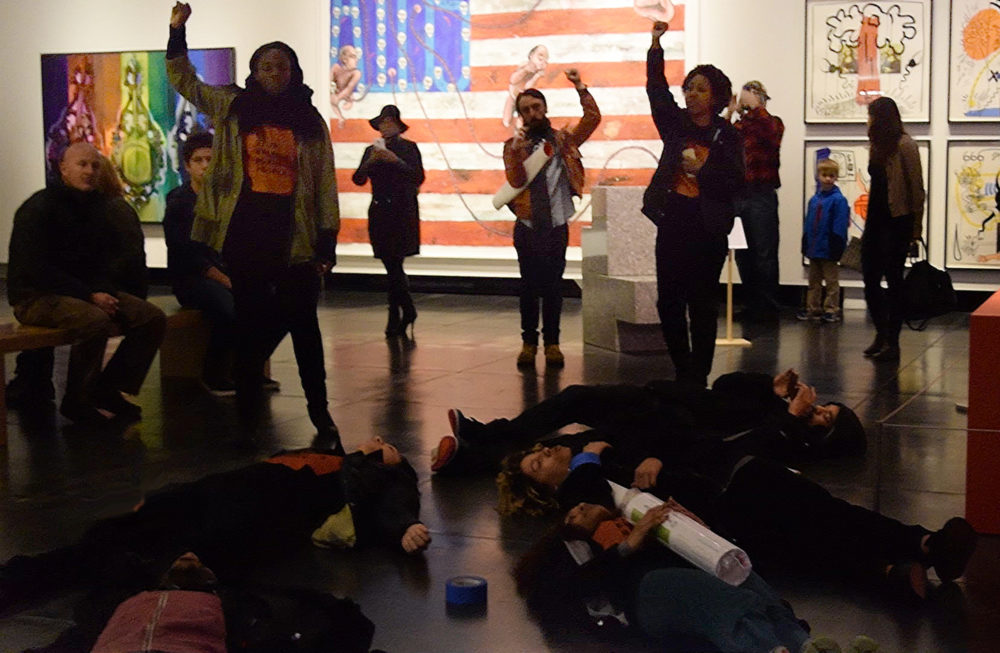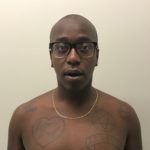Day With(out) Art 2017 curators Erin Christovale and Vivian Crockett and Visual AIDS invited the Tacoma Action Collective to provide a statement on their intervention in the exhibition Art AIDS America. See here for more on Day With(out) Art 2017.
#StopErasingBlackPeople - Historical Lands
Leveraging the information age to decolonize the past
By Tacoma Action Collective
Our historical lands are not recognized.
When we, the Tacoma Action Collective, saw a national art exhibit claiming to represent 30 years in HIV/AIDS history included only 5 Black artists, out of 107 participants, we knew it had to be stopped. This was not an issue of diversifying an art canon. This was a matter of life and death.
This whitewashed exhibition, titled Art AIDS America, was migrating from Tacoma to Atlanta, New York City, and Chicago—three cities where the disproportionate impact of HIV/AIDS on Black communities continues to unfold. Currently, Black Americans are 40% of all U.S. HIV related deaths and 44% of new HIV diagnoses. However, by orbiting fundamentally around white-male voices, Art AIDS America was not only insinuating the U.S. HIV/AIDS crisis was primarily in the past, but also propagating the illusion that nearly half of the crisis had never taken place.
In requesting these dangerous omissions be addressed, we were told by the curator: "You’ll have to wait for the next one." Meanwhile, in a time where we are historicizing the AIDS crisis, and where new developments like Truvada are being heralded as the end times of HIV, much of Black America can't access or afford these treatments, and the silent crisis of HIV/AIDS in our communities persists outside of public view.
We would not have the HIV/AIDS treatments we have today without having demanded visibility with grassroots activism and protest art. We cannot and will not wait. And because we will not wait, the Tacoma Action Collective intervened with a die-in protest at the Tacoma Art Museum to acknowledge the over 270,000 Black lives lost to AIDS who were being erased from the story. 1 Black people in the U.S. and worldwide continue to die from AIDS in a time where AIDS is preventable and treatable. We demanded:
- The Art AIDS America exhibition roster be changed to include the Black community, centering Black HIV+ artists.
- Undoing Institutional Racism (UIR) training at all levels of leadership among Tacoma Art Museum personnel.
- Black representation at all levels of Tacoma Art Museum leadership.
Six months later, in our presentation at the 2016 International AIDS Conference in South Africa, we listened to the stories of delegates from Kampala, Lagos, Durban, and across the African Diaspora about how the conference itself was erasing the organizing and leadership of Black frontline communities. Furthermore, how the global HIV/AIDS treatment industry continues to leverage their crisis and labor for resources while systematically excluding African folks from positions of power in the HIV/AIDS response. Our collaborative Twitter storm that day made #StopErasingBlackPeople the #2 trending topic in Durban.
In an interview that week these stories were echoed by Kenyon Farrow (the U.S. and Global Health Policy Director for Treatment Action Group) who thoroughly detailed how in a typical U.S. HIV/AIDS non-profit, Black staff will only be employed at entry-level community outreach positions, and almost never at higher levels of leadership. Despite being on the front lines across the planet, we are customarily excluded from power and agency in the healing of our own communities.
There are white artists representing the impact of AIDS on culture at a museum in The Bronx. And European vacationers serving as spokespeople on AIDS care and prevention at a conference in South Africa.
Our historical lands are under siege.
In the history of HIV/AIDS, there’s a correlation between the systemic dissolution of Black & Latinx communities through planned shrinkage in “the burning of the Bronx,” and the relocation of indigenous Africans to mining labor camps under the Apartheid regime. “Contagious housing destruction” is defined in the pivotal study, A Synergism of Plagues, as the process of ongoing disruption of communities through severe housing instability as a result of governmental divestment.2 This housing destruction is also one of the key structural contributors to an ongoing AIDS crisis. The forces of mass displacement make it virtually impossible to prevent the spread of HIV. In fact, this fracturing of communities rapidly accelerates the epidemic by disconnecting people from their basic social and economic supports. How can we end the HIV/AIDS crisis while our communities experience redlining and economic colonization?
From Tacoma to Durban, from The Bronx to Johannesburg, present-day struggles against gentrification are paralleled by the ongoing struggle for land rights of indigenous South Africans and Africans across their own continent—two sides of a single coin within the economics of legislated anti-blackness and erasure. “Continuous housing destruction” is our reality.
Our territory is stolen
Our people are removed
Our homes are dismantled
Our stories are colonized
Our activism is gentrified
Our historical lands are occupied.
Benevolent white-supremacy seems to be most effective at equilibrium. It is okay with us existing---but never in community, never on our own land, and definitely never in sovereignty. It is occasionally interested in our stories being told—but never by us, never to us, and absolutely never on our terms.
Curator Rock Hushka illustrates this equilibrium through his and Jonathan David Katz' white-centric curatorial strategy for Art AIDS America. As Hushka explains: "All of these artists took whatever tools were around them and they appropriated, which is a fancy word for stole, techniques from Feminist artists, Chicano artists, and African American artists for their work.”
When asked to clarify artists of color being represented by proxy, Hushka continued: “It’s the idea of inherent racism, of taking an art practice developed by the Latino community or the African American community, and then using it for their own devices. … Because they stole this, all of those things are being transmitted to the next generation."3
According to this logic Black and Latinx feminist histories are adequately represented in Art AIDS America as residue, “transmitted” vicariously through white men. When our authorship is erased, our intersections are erased along with it. In dismissing the work of Black artists, Katz and Hushka dismiss the structural foundations on which the HIV/AIDS crisis is built. They erase the housing, education, and employment discrimination that lead to Black trans women reporting exponentially higher rates of HIV diagnoses than any other demographic. They erase the Black trans origins of the LGBT movement. They erase mass incarceration and the criminalization of HIV. They reduce Black experiences to aesthetics and intellectual property which they can steal and sell. By extension they convince the public that Black people are inherently poor, as opposed to redlined; and innately diseased, as opposed to colonized. They cover their tracks.
"We need more black people talking and not merely being the subject matter at #AIDS2016 #stoperasingblackpeople" - @inaturelle
Given the continuous destruction we experience, Black liberation is intergenerational by necessity. Preserving our histories allows us to collaborate with the past and the future. #StopErasingBlackPeople is a demand to decolonize the production of the past, allowing these future collaborations to take place. #StopErasingBlackPeople exists to connect Black artists, archivers and community organizers across the diaspora to disrupt the erasure of Black activism, Black authorship, and Black community. #StopErasingBlackPeople calls for a collective economics which works across our diaspora communities to center the voices of those made most vulnerable by legislated antiblackness, misogynoir, capitalism, and ableism. We recognize history itself as a critical battlefield in our sovereignty struggle. We are taking our lands back.
We were elated when Visual AIDS shared that they were commemorating Day With(out) Art 2017 by commissioning films from Tiona Nekkia McClodden, Kia Labeija, Mykki Blanco, Tourmaline, Thomas Allen Harris, Brontez Purnell, Cheryl Dunye, & Ellen Spiro. We thank these artists for excavating Black histories, creating the present, and imagining alternative futures. This is what radical beginnings look like. Let’s continue to the end.
You can participate in #StopErasingBlackPeople by:
- Divesting from white led arts and HIV/AIDS institutions and paying tithes to intersectional Black-led community organizing
- Signal boosting and co-conspiring with Black frontline communities in the global struggle for land, housing and space
- Investing in the preservation of Black histories throughout your community
- Directly supporting Black-poz organizers and creators to further their work
- Non-Black people: Recognizing the stolen territory you profit from and resourcefully returning that power to where it belongs
- Black folks: Operating with accountability to our frontline communities and to our most vulnerable; building relationships across the diaspora
Until liberation,
Tacoma Action Collective
Tacoma Action Collective is a Black-led partnership of community organizers working in grassroots action and education in Washington State. @Tacoma_Action
1 Fields, C. Virginia. "Top 5 Stories Involving Black People and HIV in 2015." The Huffington Post. December 31, 2015. https://www.huffingtonpost.com/c-virginia-fields/top-5-stories-involving-b_b_8899392.html
2Wallace, Rodrick. "A Synergism of Plagues: "Planned Shrinkage," Contagious Housing Destruction, and AIDS in the Bronx." Environmental Research, no. 47 (January 4, 1988): 1-33. https://macaulay.cuny.edu/eportfolios/braine2014/files/2014/03/Wallace1988.pdf
3Jordan, Christopher. ""You’ll have to wait for the next one" Rock Hushka’s case for the exclusion of Black artists from Art AIDS America." Post Defiance. December 17, 2015. http://postdefiance.com/exclusion-of-black-artists-from-art-aids-america/




